Barbara Gould
The Barbara Gould line was started in 1928 by Woodworth, an old American company which produced a range of perfumes, flavouring extracts, toiletries and hair-care products. Woodworth had offices at 392 Fifth Avenue, New York and a factory, the Rochester Chemical Works, in Main Street, Rochester. By the late 1920s, about 85% of its business was in cosmetics including a range of face powders. In 1927, it introduced a skin-care product called Weather Cream and the following year it created the Barbara Gould line, registering Barbara Gould Ltd. at its New York offices.
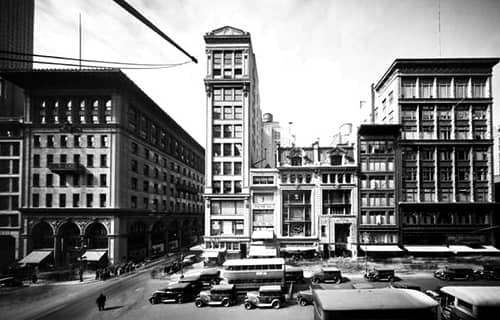
Above: c.1925 The west side of Fifth Avenue. The tall building in the centre on the corner of West 36th Street is 392 Fifth Avenue, New York. Constructed in 1913, it no longer stands.
The driving force behind the creation of Barbara Gould seems to have been Ralph Harris Aronson [1888-1935], the president of Woodworth, Inc. He married Edwarda Gould in 1917 and the couple had two daughters, Jean Joel Aronson, born April 25, 1923, and Barbara Gould Aronson, born September 6, 1924. This suggests that Aronson named the new company after his 4-year-old daughter.
Barbara Gould products first went on sale in the United States and Canada in 1928. The advertising account was given to the Redfield-Coupe Advertising Agency based in Manhattan and their early placements often combined Barbara Gould face creams with Woodworth face powders. However, this stopped soon after Woodworth merged with A. Bourjois & Co. (New York) in February, 1929.
Bourjois
Woodworth and Bourjois were combined through a stock-swap deal with The International Perfume Company, Inc., a new corporation set up to facilitate the consolidation. Pierre Wertheimer [1888-1965] and his brother Paul Wertheimer [1883-1948] controlled Bourjois, and they travelled to New York to seal the deal.
The merger gave Bourjois access to Woodworth’s American distribution network which included the largest drug store chains in North America. Pierre Wertheimer was made president of International Perfume and Ralph Aronson became its vice president and general manager.
What started out as a merger resulted in the demise of Woodworth. In November, 1929 – after the Wall Street crash in October – the stockholders of International Perfume voted to rename the company Bourjois, Inc. (New York) and from January, 1930, products branded as Woodworth disappeared or were rebadged as Bourjois.
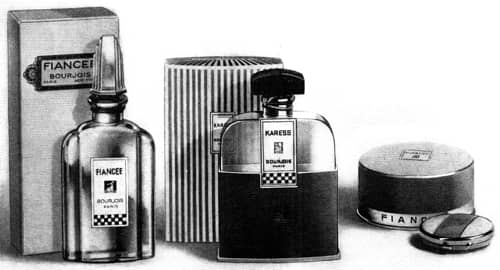
Above: 1931 Woodworth Fiancee and Karess perfumes and powders repackaged as Bourjois.
See also: Bourjois
The demise of Woodworth did not mean the end of the Barbara Gould and the brand was expanded by Bourjois both within the United States and overseas. Product development for the line appears to have been done in Paris in the Chanel/Bourjois laboratory run by Ernest Beaux [1881-1961]. Beaux may have reformulated cosmetics he had previously made for Rallet and there are suggestions that some Barbara Gould cosmetics were ‘recycled’ from Chanel and/or contained fragrances originally made for Chanel such as ‘Une Idée de Chanel’ and ‘Rose de Chanel’ (personal communication, 2018).

Above: Extract from a workbook from Laboratory Chanel (1930) for the formula for Barbara Gould Complexion Dressing in the handwriting of Ernest Beaux or an assistant.
Miss Barbara Gould
In 1928, the Barbara Gould line was described as the ‘private formulas of a noted and exclusive specialist now available publicly at a modest price’. The person assuming the role of Barbara Gould appears to have been Ruth Eliza Francis, born in Buffalo, New York State in 1899. Almost nothing is known about her but she may have had a theatrical background. Promoted overseas as an ‘American Beauty Specialist’ she was attractive with good skin and the skills and maturity to do store promotions and front the radio programs that began in 1929, the year after Bourjois launched its radio program ‘Evening in Paris’ in the United States.
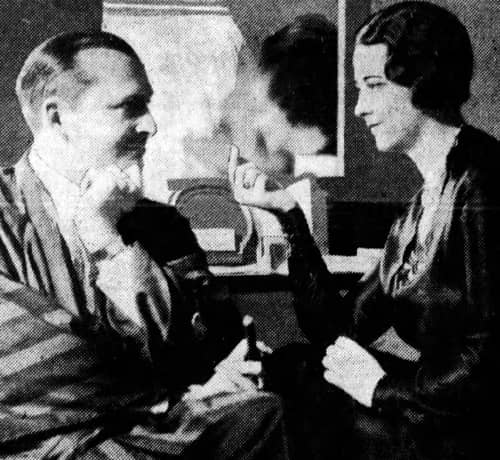
Above: 1933 Miss Barbara Gould (Ruth Francis) with ‘The Old Maestro’, Ben Bernie [1891-1943] in Indianapolis.
Although Ruth Francis played the role of Barbara Gould, the signature on the bottom of many Barbara Gould advertisements of the period was not hers. This was done in the handwriting of another woman, Olga Peterson.

Above: Barbara Gould trademarked signature.
Bourjois added to the Barbara Gould range and expanded the brand overseas, starting with a Barbara Gould salon at 1 Avenue du Président-Wilson, Paris in October, 1930, formally opened by Miss Barbara Gould in January, 1931.

Above: 1931 Miss Barbara Gould (Ruth Francis) arriving in Paris. The other woman in the photograph is Marlene Dietrich [1901-1992] (Comoedia newspaper, 23 February, 1931).
By the end of 1931, other Barbara Gould salons had opened in London, Berlin, Prague, Rome, Vienna, Budapest and Milan. I have not found any evidence of the company opening new salons in other American cities which suggests that the New York salon acted as a flagship for sales through outlets across North America.
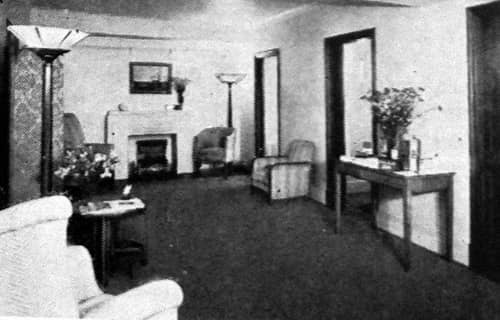
Above: 1931 Reception room in the London salon.
In 1932, two months after the American Federal Government introduced a new 10% excise tax on cosmetics, the American business was restructured. Barbara Gould Ltd. was merged with Bourjois, Inc. and two new distribution companies were set up – Bourjois Sales Corporation and Barbara Gould Sales Corporation – based at the corner of Capon and South Streets, Rochester. The new corporate structure created problems with the American Internal Revenue Service (IRS). The IRS saw the restructure as a taxation reduction strategy, took Bourjois to court, and won the case after appeals in 1936.
See also: Bourjois (post 1930)
In 1935, Ralph Aronson died unexpectedly following an emergency operation. After his death there were a number of changes in the way Barbara Gould was marketed. The company’s signature logo was updated, new containers were introduced and the contract Ruth Francis had with the company seems to have been terminated. Her last broadcasts for Barbara Gould were in 1936 and references to her in company literature disappear after that date.

Above: The Barbara Gould signature updated in 1935. The old signature persisted in advertising outside the United States.
The changes also saw Barbara Gould separated once more from Bourjois with Barbara Gould, Inc. being incorporated in the United States in 1937 after Bourjois lost its court cases with the IRS. However, the new company appears to have only been responsible for sales and distribution with all product development and manufacture still being conducted by Bourjois.
Skin-care
The original Barbara Gould skin-care range consisted of seven creams, one of which was the previously mentioned Woodworth Weather Cream (1927).

Above: 1928 Barbara Gould Creams.
Cleansing Cream: “Twice daily, at least. Use this cream freely. Pat it on—and notice how quickly it melts into a soothing, cleansing oil, reaching and purifying the countless pores of face and neck, brightening your entire complexion as soap and water can never do, giving to your skin the glow of health and enabling it to breathe its way to greater beauty.”
Cold Cream: “Smooth, soft, fragrant—it brightens and refreshes the complexion that requires nourishing oils to counteract a natural tendency towards dryness.”
Tissue Cream: “In a sense a tonic for the skin, retarding the mark of passing years and tending to restore the contour of youth to face and neck.”
Astringent Cream: “A corrective influence in the reduction of enlarged pores which are sometimes so fatal to an otherwise beautiful skin. Mild, with its use, you will observe, gradually, a refining of the skin texture and a much finer grain to its surface.”
Vanishing Cream: “Inviting because of its snowy whiteness and purity. Use it always, before powdering, to avoid so frequently resorting to powder puff or vanity case, and for the assurance that your complexion will possess a smooth, even tone for hours at a time.”
Weather Cream: “Complexion protection! Designed to protect the skin from the elements—and to relieve it from the roughening effects of exposure. Apply it before and after your outdoor hours. Also recommended for sunburn.”
Hand Cream: “A speciality for hands that desire to appear youthful. it softens, soothes and whitens; it tends to refine the skin texture by relieving any roughened condition.”
In 1929, the Vanishing Cream was replaced with Barbara Gould Finishing Cream. Company advertising stated that soap was eliminated from this new cream which suggests that triethanolamine had been substituted for the sodium or potassium hydroxide used in the earlier Vanishing Cream.
Finishing Cream: “[T]he perfect powder base. Soap, which is the base in most finishing cream, is eliminated, and a lotion substituted, insuring you against that shiny, sticky glaze which usually appears a few hours after one of the old-type finishing creams has been applied.”
See also: Vanishing Cream
In 1929, Barbara Gould Astringent Lotion and Barbara Gould Skin Freshener were added to the line and the seven creams were organised into the Barbara Gould ‘Four Ages of Beauty’, a system that grouped the skin-care cosmetics according to a woman’s age. The system started with Barbara Gould Cleansing Cream – a mixture of spermaceti, ceresine wax, mineral oil and petrolatum – and Barbara Gould Skin Freshener – a light, pink-coloured solution of ethyl alcohol – with a new Barbara Gould skin cream added as women progressed from their teens to forty and beyond.
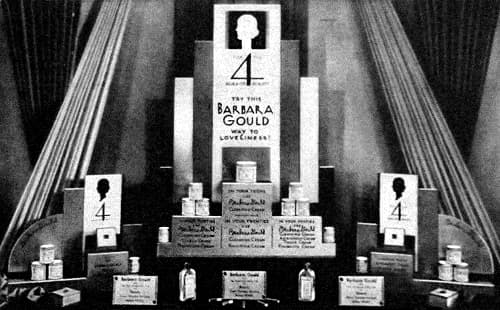
Above: 1931 Window display of the ‘Four Ages of Beauty’.
Teens: Barbara Gould Cleansing Cream and Skin Freshener.
Twenties: Barbara Gould Cleansing Cream, Finishing Cream and Skin Freshener.
Thirties: Barbara Gould Cleansing Cream, Finishing Cream, Tissue Cream and Skin Freshener.
Forties and Beyond: Barbara Gould Cleansing Cream, Finishing Cream, Tissue Cream, Astringent Cream and Skin Freshener.
There are Four Ages of Beauty—and I have formulated Four Creams which are all you need to meet the progressive needs of the skin during each age. Simplicity is the keynote of the Barbara Gould method.
In Your Teens: Thorough, gentle, daily cleansing with Barbara Gould Cleansing Cream is all your young skin needs to retain its glowing beauty.
In Your Twenties: Add the protection of Barbara Gould Finishing Cream, the ideal base for powder and rouge. It cannot reappear in a shine.
In Your Thirties: Cleansing, protection, of course—plus the extra nourishment of Barbara Gould Tissue Cream for underlying cells and tissues.
In Your Forties and Beyond: Cleansing, protection, extra nourishments—and the stimulation of Barbara Gould Astringent Cream to whip up lax circulation.(Barbara Gould advertisement, 1929)
See also: Any woman can look lovelier (1931)
In 1933, the company used these Four Ages when it introduced the first perfumes developed for the brand, aptly named Barbara Gould No. 10, No. 25, No. 30 and No. 40.
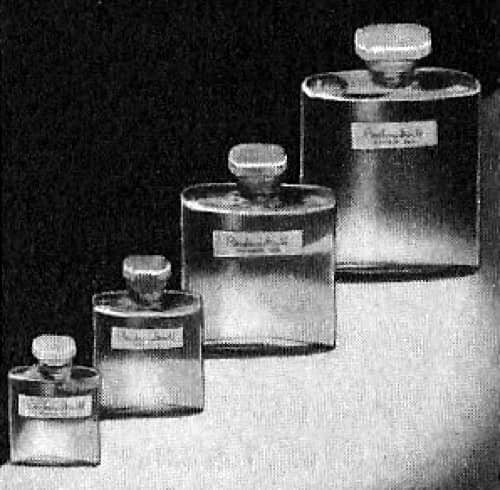
Above: Barbara Gould No. 10, No. 25, No. 30 and No. 40 perfumes. Each came in four sizes.
See also: Any woman can look lovelier (1935)
Skin types
After 1935, as part of the marketing changes mentioned previously, the ‘Four Ages of Beauty’ was dropped from advertising and Barbara Gould switched to organising its skin-care cosmetics by the more traditional use of skin types: Normal, Oily and Dry. The company had used these before 1935 but now they became central with Barbara Gould products promising to ‘normalise’ dry or oily skin.
Oily Skin
Oily Skin was considered by Barbara Gould to be caused by the pores of the oil glands becoming ‘enlarged and lax—losing their normal ability to close’.
‘Normalising’ oily skin started with cleansing with Barbara Gould Cleansing Cream. This could be alternated with soap and water but, if the skin was really oily, soap and water could be used alone.
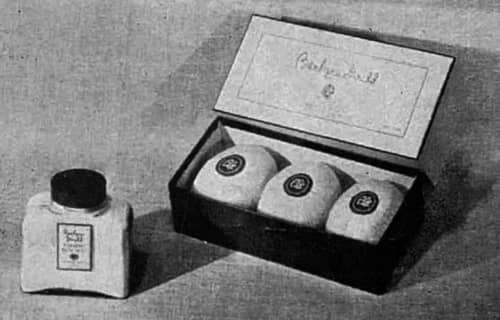
Above: 1938 Barbara Gould Foaming Bath Mist and Soap.
Cleansing was followed with an application of Barbara Gould Astringent Cream left on the skin for twenty minutes before being removed with Barbara Gould Liquid Astringent. The Liquid Astringent would clear any remaining oil and, like the Astringent Cream, help ‘firm and tone the pores’.
See also: Skin Tonics, Astringents and Toners
As well as tightening pores, astringents were believed to stimulate circulation. In 1933, Barbara Gould reinforced this idea with Barbara Gould Circulation Cream. This ‘circulation improver’ was said to be ‘stingy’ which suggests that, like other circulation creams, it contained a mild irritant – possibly oil of capsicum. This would create a feeling of warmth and a slight reddening of the skin, both regarded as symptoms of improved blood flow.
Circulation Cream: “By coaxing a steady, vigorous flow of life-giving blood to the face, it aids the skin in throwing off its old, dull, dead surface. It refines and tones at the same time.”
See also: Circulation Creams
Dry skin
The ‘normalising’ treatment for dry skin had a morning and evening regime. At night, the skin was cleansed with Barbara Gould Cleansing Cream and then massaged with Barbara Gould Tissue Cream into which a few drops of Barbara Gould Muscle Oil had been added. Most of this mixture was then wiped off but some could be left on the skin overnight for extra ‘nourishment’. Both muscle oils and skin foods were traditional anti-aging preparations of the time.
See also: Skin Foods and Muscle Oils
In the morning, the skin was cleansed again with Barbara Gould Cleansing Cream before being patted over with Barbara Gould Skin Freshener. Barbara Gould Finishing Cream was then smoothed in before applying make-up.
These ‘normalising’ treatments for oily and dry skin underwent developments through the 1930s. First, in 1935, Barbara Gould Special Cleansing Cream, was introduced for dry or normal skins.
Special Cleansing Cream: “This lovely, rose-tinted cream is made of the purest oils which smooth and soften the skin at the same time that they loosen impurities and remove dust and grime from the surface of the skin and pore-openings. It is particularly effective for the removal of make-up.”
Then the older cleansing cream was replaced by, or renamed as, Barbara Gould Cleansing Cream (Liquifying) and was now only recommended for skin that was oily.
See also: Liquefying Cleansing Creams
In 1941, Barbara Gould introduced Cream Pompon, an updated cold cream formulation possibly introduced to replace the Liquefying Cleansing Cream. It was normally recommended for skins that were in the normal or oily range.
Barbara Gould Cream Pompon: “[A] delightfully different cleanser . . . light, fluffy, emulsified. For any type of skin . . . normal oil or slightly dry.”
In 1938, the new American Food, Drug and Cosmetic Act (FD&CA) outlawed terms like muscle oil, tissue food and skin food in the United States and this was probably why Barbara Gould Special Dry Skin Cream was added in that year. In a sense, this new cream combined the Barbara Gould Tissue Cream with the Barbara Gould Muscle Oil, both products the company had been obliged to remove from sale.
Special Dry Skin Cream: “[I]t’s extra-rich, extra lubricative, extra penetrating. Don’t let those starved, shrunken skin cells of yours continue to suffer . . . or your looks will suffer, too.”

Above: c.1937 Barbara Gould counter in a drug store.
Barbara Gould Velvet of Roses Dry Skin Cream was added in 1939. This tea-rose-tinted cream perfumed with Attar of Roses was recommended for medium-dry skin and to protect all skin types from dry air when the weather was cold. It could perhaps be considered a successor to the discontinued Barbara Gould Weather Cream.
Velvet of Roses Dry Skin Cream: “A cream to aid dry skins, and a splendid cold-weather cream for all skins. Cool, rich and soothing.”
Both Barbara Gould Special Dry Skin Cream and Barbara Gould Velvet of Roses Dry Skin Cream could be used as night creams but this did not stop the company adding Barbara Gould Night Cream by the end of the decade. For good measure, it also introduced Barbara Gould Special Eye Cream for the delicate area around the eyes in 1939.
Night Cream: “[H]elps keep your skin looking smooth, soft and gloriously fresh; and discourages the formation of fine surface lines and wrinkles that result from dryness of the skin.”
Special Eye Cream: “Richest of all Barbara Gould creams, this special purpose preparation is blended specifically for use on the delicate tissues around the eyes. It is an extremely fine-textured cream for keeping this fragile skin soft and supple.”
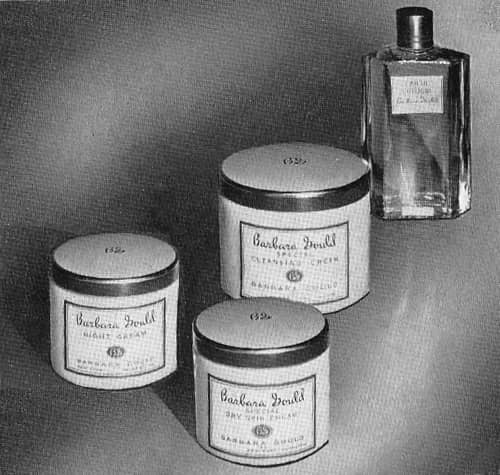
Above: 1940 Barbara Gould Night Cream, Cleansing Cream, Special Dry Skin Cream and Eau De Cologne.
Irradiated Skin Food
In 1934, Barbara Gould launched Irradiated Skin Food and Face Powder. The skin food was advertised as containing the ‘health-giving rays of sunlight’ which would coax ‘tired, sluggish glands to normal vigor and health’. Irradiating a cream with ultra-violet light was supposed to make it full of ‘atomic oxygen’ that was released into the skin to produce a ‘revitalizing, rejuvenating and normalizing effect’.
Irradiated Skin Food: “While you sleep, rays are gently, slowly, safely, shed upon your skin. But so mild are these rays, so safe, that they only give the benefits of sunshine without tanning, without giving you a sunburn&rdquo.
In 1935, Irradiated Skin Food became Irradiated Skin Cream and became part of the Barbara Gould ‘Simplified Treatments for Dry and Oily Skin’ introduced in 1936. However, rather than being ’simplified’ these new regimes were at least as, if not more complicated than what had been recommended before.
Both Irradiated Skin Cream and Irradiated Face Powder were subjected to a cease and desist order from the U.S. Federal Trade Commission (FTC) in 1935. Claims for the products were scaled back but the Irradiated Skin Cream was still around in the late 1940s before it appears to have morphed into Barbara Gould Beauty Cream.
Beauty Cream: “[A]n irradiated blend of oils to help your complexion keep the petal-like softness inherent in a fresh, normal skin.”
Throat and neck
In the early 1930s Barbara Gould could only suggest treating the throat and neck with Tissue Cream and strengthening the throat muscles with exercise.
You can help to correct a double chin by strengthening the muscles about the chin. Try this little exercise. Relax, throw back your head, then open and close your mouth ten times. Do this frequently during the day.
(Barbara Gould, 1935, p. 19)
See also: Facial Gymnastics
This changed in 1939 when the company created products and a treatment regime specifically for the throat and neck. This involved strapping a pad of cotton wool saturated with Barbara Gould Firma-Tone – a liquid astringent – under the chin with the complementary Barbara Gould Chin Strap. After 15 to 20 minutes, the chin strap and pad were removed and the skin was then patted with warm Barbara Gould Throat and Neck Oil – a replacement for the earlier Muscle Oil. Promoted as new, it was yet another ‘tie-up’, a home and salon treatment that had been available from other companies for decades.
See also: Straps, Bandages and Tapes
Like Irradiated Skin Cream, Firma-Tone also created difficulties with the FTC which forced Barbara Gould to stop using the name and to ceasing claiming that it could ‘firm’ facial and neck contours or ‘tone’ skin or muscles in 1940.
Masks
In 1936, Barbara Gould introduced Plastic Cream, the company’s first mask. It was used to help to erase fatigue, age lines and discolouration and ward off blackheads, large pores and drabness by encouraging good circulation. Said to contain the ‘most absorbent substance known to science’ this suggests, along with its other features, that it was a combination of an astringent and a mild bleach in a creamy clay base. It was applied in a thin film over the face and neck and then washed off 20 minutes later. The effect was supposed to last from between 4 and 24 hours.
See also: Clay Masks
A second mask, Barbara Gould Mild Astringent Cream, was added by 1940.
Mild Astringent Cream: “A refreshing snowy-white mask whose use brings a glow to the skin. Recommended in the care of oily skin, and complexions marred by blackheads and clogged pore conditions.”
Special problems
Early Barbara Gould skin-care advice mentions common skin problems such as freckles, pimples and blackheads but had little to offer by way of treatment. There was more help for sallow skin which was considered ‘undernourished’ a condition that could be exacerbated by fatigue, lack of exercise and sluggish circulation. As they were added to the line, Barbara Gould Liquid Astringent, Circulation Cream, Irradiated Cream, Plastic Cream, and Mild Astringent Cream were variously recommended as treatments to improve circulation and general skin health considered the underlying problem of many skin blemishes.
Also see the booklet: Any woman can look lovelier (1940)
Sun-care
The only product in the early Barbara Gould range that could help with sun exposure was Weather Cream which was recommended for sunburn. The popularity of sunbathing increased during the 1930s and the company added Barbara Gould Sun Beauty Cream, Barbara Gould Sun Beauty Lotion and Barbara Gould Sun Beauty Oil in 1936 to cater for this trend.
Sun Beauty Cream: “[A]n effective make-up base; leaves your skin soft and delightfully fresh.”
Sun Beauty Lotion: “[F]or a light tan and as a powder foundation.”
Sun Beauty Oil: “It encourages a deep bronze tan and its oils replace the natural oils dried out by the hot sun.”
As far as I can tell there were no chemical sunscreens in any of these products and the lotion and cream only provided sun protection through pigments they contained.
Make-up
Records of Barbara Gould make-up introduced in 1928 only extend to lipstick. Rouge was in the line no later than 1930 and the company had a complete make-up range which included foundations, face powders, rouges, lipsticks, and eye make-up by 1931.
Foundation
As mentioned earlier, Barbara Gould Vanishing Cream was replaced with Barbara Gould Finishing Cream in 1929 and this product remained a staple foundation through the 1930s until it was discontinued. At some stage after 1935, the company also introduced Barbara Gould Special Foundation Lotion, a lighter foundation for women with oily skin.
Women who wanted a tinted powder base could use Barbara Gould Complexion Dressing (1929) containing alcohol, talc, magnesium sulphate, zinc oxide, glycerine, zinc carbonate and osmo-kaolin. It came in Naturelle and Rachel shades, increased to Naturelle, Rachel 1, and Rachel 2 by 1935. The product appears to have been reformulated in 1936 at which time the Rose Indian shade was added. It was considered suitable for backs and arms when wearing evening dresses and was said to conceal skin blemishes and, if several applications were used, even birthmarks.
Complexion Dressing: “A liquid make-up foundation, good for every type of skin and recommended for regular or formal wear. Excellent for neck and throat make-up because it does not rub off on the clothes.”
The resilience of the 1936 formulation enabled the Mandarin Tan shade of Complexion Dressing to be recommended as a stocking substitute during the Second World War.
See also: Liquid Face Powders and Cosmetic Stockings
In 1938, Barbara Gould added Velvet of Peaches Foundation, another tinted foundation but made as a cream not a lotion. The name seems to have been ‘borrowed’ from Bourjois who had previously used it as a rouge shade. It came in a range of shades designed to blend with Barbara Gould Face Powders.
Velvet of Peaches: “Your make-up will go on more smoothly, last much longer if you use this tinted foundation cream.”
Face Powder
Barbara Gould Face Powders seem to have appeared after the 1929 merger. By 1931, they were being produced in Naturelle, Rachel No. 1, Rachel No. 2, Tan, Rose Indian and Rose Tan shades with later shades including Desert Rose (1935), Mandarine Gold (1936), Mandarine Tan (1936), Currant Rose, and Moderne (1939), Skylark (1940), Sun Beauty (1941), May Apple (1941), and Lilting Beauty (1944). Only ten of these shades survived through to 1945.
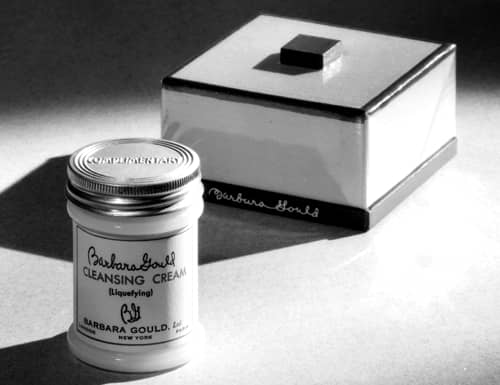
Above: 1934 Barbara Gould Cleansing Cream and Face Powder. I have no evidence that Barbara Gould Face Powder was made in different weights but a De Lux version was being produced by 1935.
By 1931, some face powder shades – Naturelle, Rachel No. 1, Rose Indian – were also available as vanities, filled with either loose or compact powder, some in combination with rouge.
Lipstick and rouge
Barbara Gould lipsticks go back to 1928. The early forms appear to have been indelibles which suggest that they relied heavily on dyes. In 1931 they came in five shades: Light, Medium, Dark, Orange, Brilliant and Koral. Shades added up to 1945 included: Desert Rose (1935); Chianti (1938); Currant Rose, Cerise, Pink Camellia, Pagan Red, and Moderne (1939); Skylark, Wine-Glo, Quartz Iridescent, and Aztec Iridescent (1940); May Apple, and Red Dash (1941); Lilting Beauty (1944); and Rose Glo (1945).
By 1931, Barbara Gould was also selling both compact and cream rouges. Barbara Gould Dry Rouge came in Light, Medium, Dark, Koral, and Brilliant shades but the Barbara Gould Cream Rouge was only available in Medium, Koral, and Brilliant.
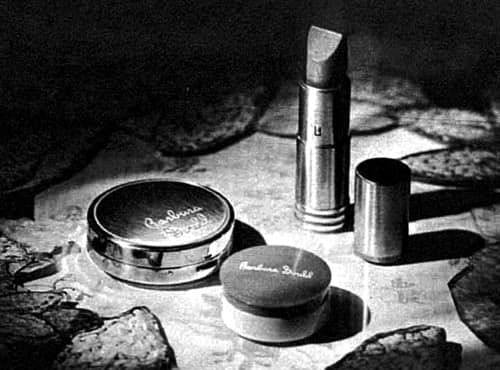
Above: 1939 Barbara Gould Compact Rouge, Cream Rouge and Lipstick in Moderne shade.
By 1935, Light had been added to the cream rouge and the compact rouge had been reformulated. This new dry rouge now came in Light, Medium, Medium 2, Koral, Brilliant, Madrid, and Radiant shades with other shades added up to 1945 matching those previously mentioned for lipstick.
Eye make-up
Eye make-up consisted of Barbara Gould Eyebrow Pencil in Black and Brown shades, Barbara Gould Eyeshadow in Light Blue, Dark Blue, Violet, Gray, Brown, and Green shades and Barbara Gould Mascara in Black, and Brown shades. These shades did not change until after the Second World War except for the mascara which had Blue, and Blue-Green shades added to it by 1940.
Color coordination
The shade range of Barbara Gould make-up was limited but was colour coordinated. Eyeshadow was matched to eye colour, powder with complexion and hair colour, and lipstick shades generally matched with rouge. There were also suggestions for daytime and evening make-up and a make-up scheme for summer when the complexion was tanned.
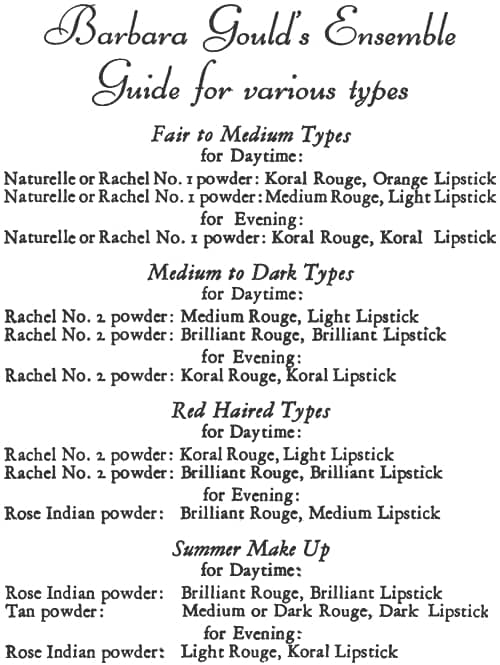
Above: 1931 Barbara Gould Ensemble Guide.
The ensemble idea was continued through to 1935 with additions as new shades were introduced.
Also see the booklet: Any woman can look lovelier (1935)
In the fall of 1936, as a complement to its campaign towards ‘Simplified Treatments for Dry and Oily Skin’ Barbara Gould introduced ‘Simplified Make-up’, offering three coordinated colour schemes based on costume colours.
Group 1 for daytime bright and deep greens, clear reds and browns: Mandarine Gold face powder, Parisienne rouge, and Koral lipstick;
Group 2 for daytime blacks, rose and purplish reds, deep pinks, purplish blues, purples and raspberry reds: Deep Brunette face powder, Brilliant rouge, and Brilliant lipstick;
Group 3 for evening lames and other metal-shot fabrics and gleaming satins: Naturelle face powder, Madrid rouge and Light lipstick.
Barbara Gould continued with the idea of matching cosmetics with clothing colours but focussed on doing this with lipstick and rouge. Face powder shades were to be selected by skin tone not costume.

Above: 1940 Barbara Gould Costume Colors.
See also: Any woman can look lovelier (1940)
Hands and nails
The Barbara Gould Hand Cream was one of the seven creams introduced by Woodworth in 1928. A lighter Barbara Gould Hand Lotion, a perfumed, glycerine jelly made with alcohol, glycerine and distilled water, thickened with tragacanth gum was added to the range by 1933.
Hand Lotion: “A rich lotion that should be used immediately after washing the hands to keep them soft and smooth. It disappears rapidly into the skin and is not sticky or greasy.”
See also: Glycerine Creams and Jellies
By 1931, Barbara Gould was making a liquid nail polish in Naturelle, and Rose tints, removed with Barbara Gould Liquid Polish Remover. Like many other nail polishes of the time the products were crude and the bottle did not include a brush built into the lid. The company also sold complete manicure kits containing orange sticks, Barbara Gould Cuticle Remover – a simple mixture of potassium hydroxide, glycerine and water – and emery boards.

Above: 1937 Barbara Gould Hand Cream, Essential for the Nails, and Hand Lotion.
The early Barbara Gould Liquid Nail Polish polishes were coloured with dyes. They were translucent and only applied across the pink part of the nail plate to accentuate the shine and natural colouring of the nail. By 1935, these translucent polishes had given way to opaque Barbara Gould Cream Nail Polishes. These were coloured with pigments rather than dyes so were more like the nail polishes/enamels we know today. They were applied across the entire nail plate, a developing fashion in the 1930s.
See also: Nail Polishes/Enamels
Using pigments in its nail polishes enabled Barbara Gould to extend their colour range and match them with lipsticks. In 1935, Barbara Gould Cream Nail Polish came in Naturelle, Medium, Flame, Brilliant, and Koral, with Medium, Brilliant, and Koral also being shades of lipstick. Other shades added up to 1945 included Desert Rose (1935); Cerise, Rose Mist, Tez, Dresden, and Clear (1939); Red Gentian, May Apple, and Red Dash (1942); and Rose Glo (1945). Some of these shades, such as Desert Rose, Cerise, May Apple, Rose Glo, Red Gentian, and Red Dash, were also shades of lipsticks.
Skylark
In 1940, the company released the Skylark make-up range – face powder, dry rouge, cream rouge, lipstick and nail polish – in a tone that was said to be ideal for blues but could also be used for “pinks, browns, rosy tans, greys, greens, pastels, beige, black or white“.
The following year Barbara Gould added Skylark perfume and Skylark fragranced cologne, dusting powder, talc, bath bubbles, beauty soap, and bath soap, making it the first fragranced-based line for the company. It was heavily advertised in America right through the Second World War.
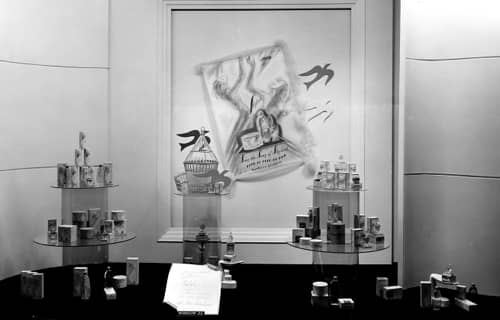
Above: 1941 Window display for Barbara Gould Skylark range at the J. H. Hudson Company Department Store (Detroit Historical Society).
Wartime
When Germany invaded France in May, 1940, the Wertheimers fled Paris to Bordeaux and then escaped via Spain to Rio de Janeiro. From there they travelled by ship to New York, arriving in August, 1940 where they were greeted by the vice president and manager of Bourjois (New York), Bernard M. Douglas [1867-1944].
The Wertheimers were Jewish so their assets in France were bound to be expropriated by the Nazis following the French surrender in June, 1940. They got around the problem by ‘selling’ their French assets of Bourjois to a friend, Félix Amiot [1894-1974] in October, 1940. Earlier, in June, 1940, Barbara Gould S.A. had been founded at 135 Avenue de Neuilly, Neuilly-sur-Seine, Paris. America was not at war with Germany at the time but this new French company may also have been part of an asset protection strategy.
Barbara Gould was available in Britain right through the Second World War. However, Bourjois House in Queens Way, Croydon was heavily bombed in 1940 and although it had been rebuilt by 1948, Barbara Gould stopped being available in Britain around the time the factory was officially reopened. It only became available once more when the line was relaunched in Britain in 1967 (Chemist & Druggist).
Post war
In the summer of 1945, Pierre Wertheimer traveled to London to meet Félix Amiot and begin the process of regaining and rehabilitating the Wertheimer interests in Europe including Barbara Gould.
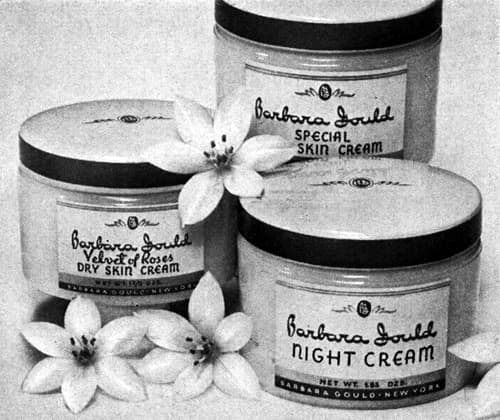
Above: 1946 Barbara Gould Special Dry Skin Cream, Velvet of Roses Dry Skin Cream, and Night Cream in post war packaging.
By 1951, the Paris headquarters of Barbara Gould had been moved uptown to 43 Avenue Marceau, the new address of Wertheimer Frères, the company that had controlling interests in Barbara Gould, Bourjois, and Parfums Chanel. This relocation was followed by the adoption of a new logo for Barbara Gould based on Leda and the Swan which was widely used in French advertising until the early 1960s. New packaging was also introduced with most of the new designs being adopted on both sides of the Atlantic.
In the United States, some rationalisation took place after Hugo Langdon Bell [1907-1992] became the new president of both Bourjois (America) and Barbara Gould in 1952. He had joined the firm in 1950, coming from Lehn & Fink where he had been vice president in charge of sales. He was fluent in both English and French which must have helped him deal with the Wertheimers and the French side of the business. One of his first acts was to combine the sales forces of the two brands.
There was some overlap between the French and American lines put out by Barbara Gould during the 1950s but there was also increasing divergence. This may be a reflection of the different positioning of the brand on either side of the Atlantic. In France, Barbara Gould appears to have maintained its standing but in the United States it seems to have gone increasingly down market. As mentioned earlier, it had disappeared in Britain sometime around 1948.
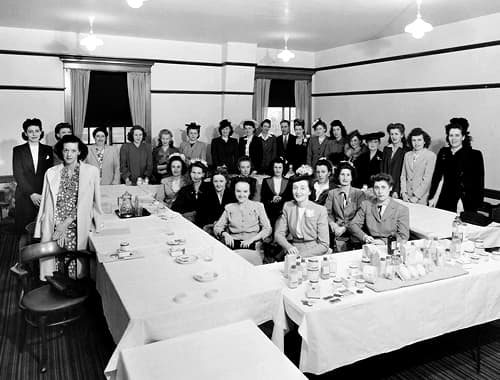
Above: 1945 Women at a Barbara Gould training program.
Skin-care
In 1949, Barbara Gould introduced a new home facial kit called About Time. Included in the kit was a a jar of Preliminary Cream, a circulation cream to quicken circulation and bring a rosy glow to the face, and a jar of Action Cream.
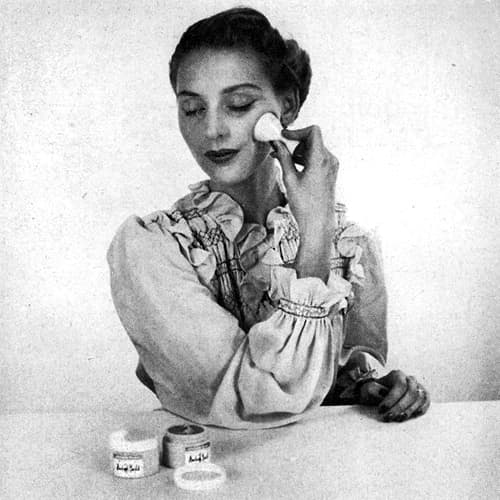
Above: 1949 Barbara Gould ‘About Time’ Facial.
The Action Cream was applied with cup included in the kit in small circular motions to firm sagging muscles and tighten contours. This attempt to revive an old beauty technique known as vacuum suction does not appear to have .
See also: Vacuum Suction
In 1951, the company then released three new new skin-care cosmetics: Revital, Moistone Cream, and Moistone Oil.
Revital: “[A] lotion consisting of delicate oils, light enough to penetrate easily, yet rich enough for lavish skin-softening results. It cleanses, it softens, it firms . . . it’s easy to use . . . it’s thorough!”
Moistone: “Rich in lanolin and delicate skin softening oils . . . makes your skin look younger, smoother almost at once. Ideal for skins that are dry or very dry.”
Moistone Oil: “Two drops . . . smoothed on your face will give your skin the dewy, silky-smooth look that is so young! Makes make-up beautiful and it’s good for your skin all the while.”
Revital was made from softening and lubricating oils, combined with herbal astringents, and was described as a one-step treatment that would cleanse, firm and lift and act as a foundation for make-up.
Both Moistone Cream and Moistone Oil could be used on any skin type before retiring at night or under make-up during the day. As their names suggests they were supposed to bestow ‘moist smoothness to the skin’. However, advertising for the products did not highlight occlusives, humectants or any other moisturising ingredients. They also arrived before Irvin H. Blank [1902-2000] published his 1952 article ‘Factors which influence the water content of the stratum corneum’ so cannot be considered to be early moisturisers.
See also: Moisturisers
Advertising for Moistone Cream and Moistone Oil stressed instead that they contained olein ozonide, said to release oxygen into the ‘oxygen-starved’ skin. This was not a novel idea. Helena Rubinstein had added triolein ozonide to her Gourielli Active Ozone Cream and made similar claims over a decade earlier.
See also: Skin Breathing and Helena Rubinstein (1930-1945)
The American company also updated its Night Cream and Throat and Neck Cream in 1952. The Barbara Gould Special Throat Cream also replaced the physical chin strap with an invisible one. The contouring effect of the cream was achieved largely through Oil of Capsicum, an irritant Barbara Gould may have also used in the previously mentioned Circulation Cream released back in 1933.
The new Barbara Gould Enriched Night Cream was fortified with vitamins A, D and E. This was rather late as many other cosmetic companies had already added vitamins to their skin creams before the war. Admittedly those 1930s vitamin creams only contained vitamin A and/or vitamin D so the addition of vitamin E was new. It had only been synthesised by the Swiss chemist Paul Karrer [1889-1972] in 1938.
See also: Vitamin Creams
Special Throat Cream: “An invisible chin strap and contour treatment in cream form. Apply after cleansing, stroke upward on throat and neck, to stimulate circulation, thus help firm flabby skin, clear dull old-looking throat and neck. Use morning and night.”
Enriched Night Cream: “Combat tiny lines and wrinkles with soothing lubricating emollient oils in this richly textured Night Cream.”
Other skin-care cosmetics added in the American market during the 1950s included: Beauty-Full Lotion (1953), a foundation that may have also acted as a moisturiser; Act of Beauty (1954), a moisturising lotion; and Winter Wonder Lotion (1956), a greaseless all-purpose emollient tinted in a pink tone.
Beauty-Full Lotion: [A] make-up foundation to wear directly under your powder, keeping your face smooth and dewy-fresh looking.”
Act of Beauty: “[T]he simple complexion care you’ve been searching for. One fluid cream—instead of a time consuming welter of night creams, day creams, moisture creams, lubricating creams. One fluid cream—to nourish, moisturize and protect your sensitive, drying skin—twenty-four hours of the day.”
Winter Wonder Lotion: “[T]he silicone formula that protects as it heals smoothing face, elbows, arms, and legs.”
In 1960, Barbara Gould extended Act of Beauty into a line with the addition of Act of Beauty Veil Vitale and Act of Beauty Facial Cleanser. The original lotion now became Act of Beauty Liquid Humectant Cream and the emphasis was firmly on moisturisation. Act of Beauty Creme Nocturna, a night cream, was added in 1964.
Act of Beauty Deep Facial Cleanser: “[W]ashes precious emollients and polyunsaturates onto the skin as you cleanse deep, deep down where trouble begins.”
Act of Beauty Veil Vitale: “[A] modern solid-liquid that effervesces and melts on contact to firm, tone, moisturize your skin, all in one simple act of beauty.”
Act of Beauty Liquid Humectant Cream: “[A] rich but light, liquid but potent fluid face cream that provides the softening protective moisture the mature skin literally thirsts for, restores a radiant, moist bloom to the complexion.”
Act of Beauty Creme Nocturna: “[T]he ultimate in luxury skin care. A matchless blending of rare and beneficial skin nutrients provides night and day loveliness. Just a few nights’ use will yield results other creams only hint at.”
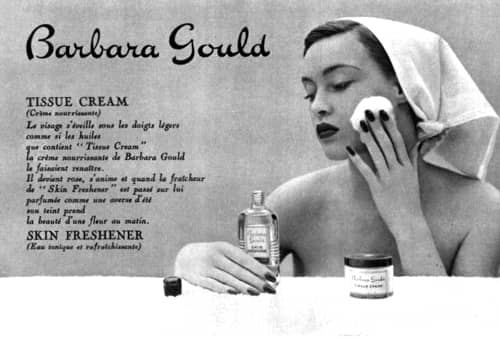
Above: 1951 Barbara Gould Tissue Cream (France).
Information on products available in France during the 1950s is limited. Known lines included: Barbara Gould Crème de Beauté, an oily skin cream that helped produced a matt make-up; Crème de Beauté B. G., a day cream and powder base for dry and normal skin; and Barbara Gould Crème Picturale, a day cream and powder base for sensitive skin.
Shark squalane
New French skin-care products of particular interest were Barbara Gould Complexion Cream and Complexion Oil. Both skin-care lines contained Cosbiol, a trade name for squalane (hydrogenated squalene) derived from shark liver oil supplied by a French company, Safic-Alcan.
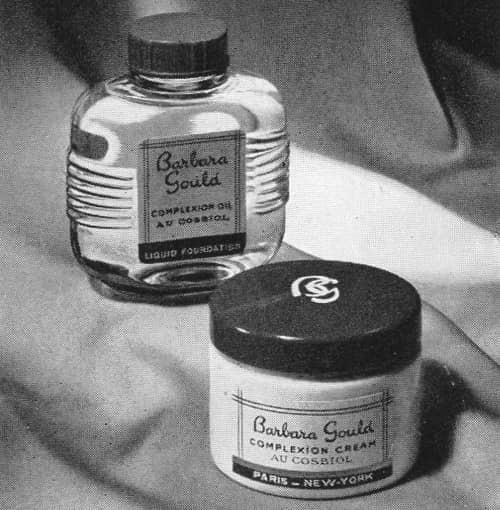
Above: 1956 Barbara Gould Complexion Cream and Complexion Oil with Cosbiol (France) in packaging used on both sides of the Atlantic.
In France, Complexion Cream and Complexion Oil were often used in conjunction with Barbara Gould Crème Textural and Barbara Gould Lotion Textural both recommended as an extra treatment for irritated skins or for skin imperfections such as pimples, scabs, blackheads and acne.
The use of English names for the Complexion Cream and Complexion Oil might suggest that there was a plan to introduce both products into the United States but I have no record of them there. However, Cosbiol was definitely added to Barbara Gould Velvet Roses Dry Skin Cream, with the new formula released in the United States in 1952.
Velvet of Roses Dry Skin Cream: “[A]ctivated with Cosbiol to soften your skin. It is quickly absorbed, marvelous for very dry skins.”
Later skin-care lines introduced in France included Barbara Gould Crème Hydrative and Barbara Gould Crème Généreuse.
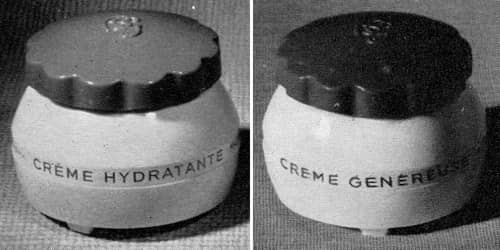
Above: 1959 Barbara Gould Crème Hydrative and Barbara Gould Crème Généreuse (France) in new packaging. Crème Hydrative was a moisturiser suitable for dry and oily skin that could be used alone or as a base for make-up. Crème Généreuse was a nourishing and stimulating cream said to revitalise the skin.
Masks
In 1951, Barbara Gould (New York) added Barbara Gould Brush-On Beauty Masque to be applied in the morning or evening with the complementary brush. It dried to a transparent film in a minute or so, firming and toning the skin. It was removed with warm water rather than peeled off but the whole treatment was only supposed to take ten minutes from start to finish.
Brush-On Beauty Masque: “A perfect, quick facial, brushes easily on your face . . . feels cool, helps wake up and smooth your skin in a few moments. Ideal pick-up for that last minute date.”
I have found no record that this masque was sold in France but there the company introduced Barbara Gould Crème Embelline. This transparent tonic and softening cream mask was said to ‘provide the epidermis with oxygen’. This suggests it may have contained the same olein ozonide used in the American Moistone Cream and Moistone Oil.
Make-up
The Barbara Gould make-up range was never strong and Information on post-war developments is very limited. However, there are three areas that deserve mentioning.
Foundations and powders
After the war, most cosmetic companies introduced new liquid and creamy compact make-up formulations that reduced the importance of loose face powders.
Barbara Gould’s new liquid make-up was Liquid Velvet of Peaches. Introduced in 1945 in the United States, it could be used as a foundation, blemish concealer, or tinted skin protectant with or without powder.
Liquid Velvet of Peaches: “It gives the skin a fresh, pearlescent look without powder, and provides a smooth, velvety, exquisitely groomed appearance worn without powder. Creamy, softening, wonderful protection for all types of skin. Retains smoothness and freshness for twelve hours.” Shades: Blonde, Brunette, Mandarine and Sun Tan.
In 1953, Barbara Gould followed this with All-Aglow, a typical pressed-powder compact that acted as a foundation and face powder in one.
All-Aglow: “A subtle blend of finely textured powder and rich, satiny smooth foundation.” Shades: Naturelle, Brunette, and Ethereal.
In 1950, Barbara Gould also made an attempt to cater to the adolescent market with a skin-coloured, foundation lotion called Barbara Gould Beauty Begins. As far as I can tell it did not contain an antibacterial and only functioned to soothe and conceal. It was applied after the morning cleansing for a smooth, matt finish.
Beauty Begins: “Does wonders for young, oily type skin—soothes and protects, conceals little blemishes, gives a smoothly powdered finish.”
Lipsticks
New lipstick shades introduced in America after 1945 included: Lover’s-Knot, Lilting Red, and Gaiety Red (1946); Moonstruck (1947); Bright Orchid, and Coral Fame (1949); Whimsical (1951); Spicy Pink, and Frankly Red (1952); and Brilliant Ruby, Folly Red, and Pink Orangeade (1953). In the 1950s, in response to the heightened interest in lipsticks in the American market, Barbara Gould introduced Lustre Last Lipsticks in black and gold cases. By 1956, these creamy indelibles were produced in seventeen fashion shades many of which had been developed in France.
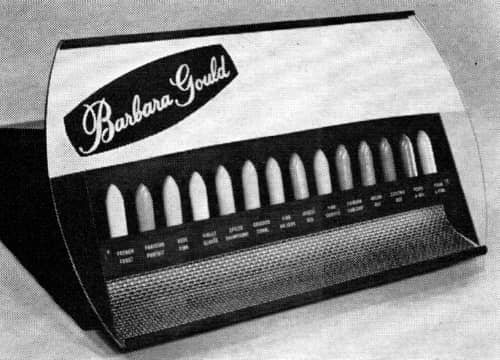
Above: 1959 Barbara Gould Lustre Last display case.
See also: Lipstick Wars and Hazel Bishop
Eye make-up
In 1959, the company debuted Barbara Gould Lash-O-Matic, an automatic mascara built like Helena Rubinstein’s Mascara-Matic (1957) with an applicator that was a metal rod not a brush. It was released in conjunction with the Barbara Gould Liquid Eyeliners. These came in five shades – Black, Brown, Blue, Green, and Amethyst – that were colour coordinated with the new mascara.
See also: Automatic Mascara
Sale
Barbara Gould’s continued decline in the United States saw it disappear there sometime after 1970. In France, the range continued to prosper but was sold to Reckitt & Colman (France) S.A. in 1987. It continued to do well there but Reckitt & Colman sold it to Carter-Wallace in 1999 as part of a rationalisation of their brands. Carter-Wallace still owns Barbara Gould today, operating it through an intermediary, Laboratoires Santé Beauté.
Timeline
| 1928 | Barbara Gould Ltd. established. New Products: Barbara Gould range. |
| 1929 | A. Bourjois (New York) and Woodworth, Inc. merged into International Perfume. International Perfume renamed A. Bourjois, Inc. Radio programming begins in America. New Products: Finishing Cream; Astringent Lotion; Skin Freshener; and Complexion Dressing. |
| 1930 | Barbara Gould Ltd. (England) established. Paris salon opened. |
| 1931 | Salons opened in London, Berlin, Prague, Rome, Vienna, Budapest, and Milan. |
| 1932 | Barbara Gould Ltd. merged with Bourjois, Inc. and Bourjois Sales Corporation and Barbara Gould Sales Corporation established. |
| 1933 | New Products: Circulation Cream. |
| 1934 | New Products: Irradiated Skin Food; and Irradiated Face Powder. |
| 1935 | New Products: Special Cleansing Cream. |
| 1936 | New Products: Plastic Cream; Sun Beauty Cream; Sun Beauty Lotion; and Sun Beauty Oil |
| 1937 | Barbara Gould, Inc. established in New York. |
| 1938 | New Products: Velvet of Peaches Foundation Cream; and Special Dry Skin Cream. |
| 1939 | New Products: Special Eye Cream; and Velvet of Roses Dry Skin Cream. |
| 1940 | Barbara Gould SA founded in Neuilly-sur-Seine, Paris. New Products: Skylark make-up range. |
| 1941 | New Products: Skylark Perfume; and Cream Pompon. |
| 1945 | New Products: Liquid Velvet. |
| 1947 | New Products: Skin Sachet. |
| 1949 | New Products: About Time home facial kit; and Personal Touch antiperspirant. |
| 1950 | New Products: Beauty Begins. |
| 1951 | New Products: Revital; Moistone Cream; Moistone Oil; and Brush-On Beauty Masque |
| 1952 | Products repackaged. New Products: Special Throat Cream; and Enriched Night Cream. |
| 1953 | Bourjois and Barbara Gould combine American sales forces. New Products: Beauty-Full Lotion; and All Aglow compact powder. |
| 1954 | New Products: Act of Beauty; Barbara Gould Complexion Cream (France); and Barbara Gould Complexion Oil (France). |
| 1956 | New Products: Winter Wonder Lotion. |
| 1959 | New Products: Lash-O-Matic; and Liquid Eyeliners. |
| 1960 | New Products: Act of Beauty line with Veil Vitale, Deep Facial Cleanser and Liquid Humectant Cream. |
| 1964 | New Products: Act of Beauty Creme Nocturna. |
| 1967 | Barbara Gould relaunched in Britain at 2 Old Bond Street, London. |
| 1987 | Barbara Gould sold to Reckitt & Colman (France) SA. |
| 1999 | Reckitt & Colman sell Barbara Gould to Carter-Wallace. |
First Posted: 20th July 2018
Last Update: 23rd July 2024
Sources
The American perfumer & essential oil review. (1906-1955). New York: Robbins Perfumer Co. [etc.].
Barbara Gould. (1931). Any woman can look lovelier [Booklet]. USA: Author.
Barbara Gould. (1935). Any woman can look lovelier [Booklet]. New York: Author.
Barbara Gould. (1940). Any woman can look lovelier [Booklet]. USA: Author.
By request. (1931). What’s on the air. May. 2(7), 17.
deForest Lamb, R. (1936) American chamber of horrors. The truth about food and drugs. New York: Farrar & Rinehart.
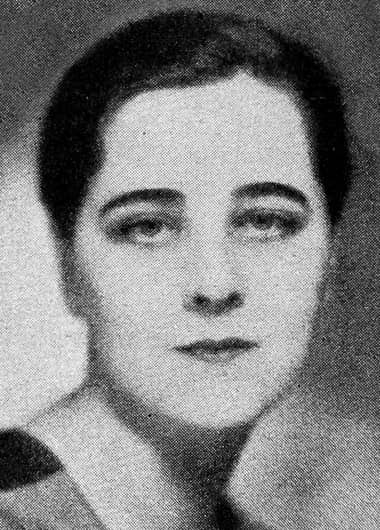
Miss Barbara Gould a.k.a. Ruth Francis [1899-1994]
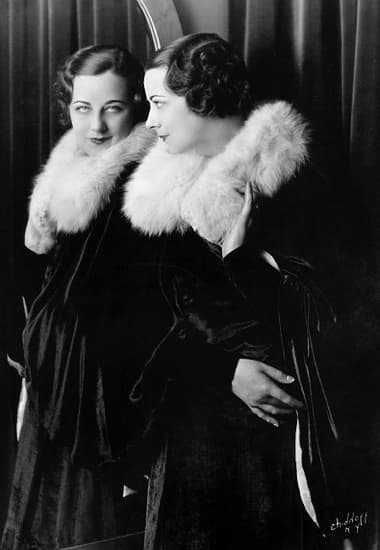
Ruth Francis photographed by the Broadway photographer Irving Chidnoff [1896-1966].
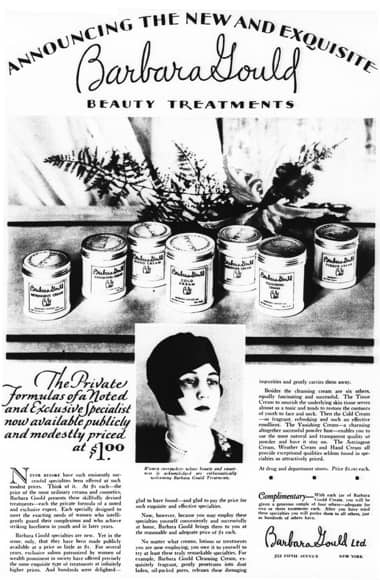
1928 Barbara Gould Beauty Treatments.
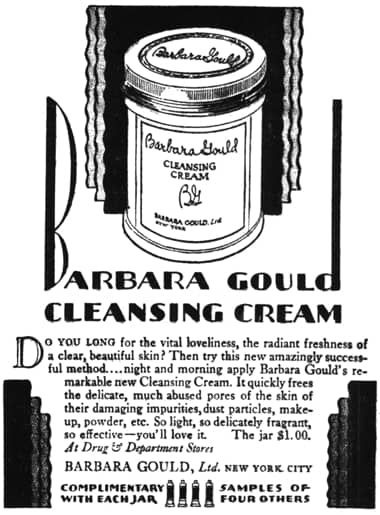
1928 Barbara Gould Cleansing Cream.

1929 Barbara Gould Cleansing Cream being advertised with Woodworth Fiancee and Karess Face Powders.
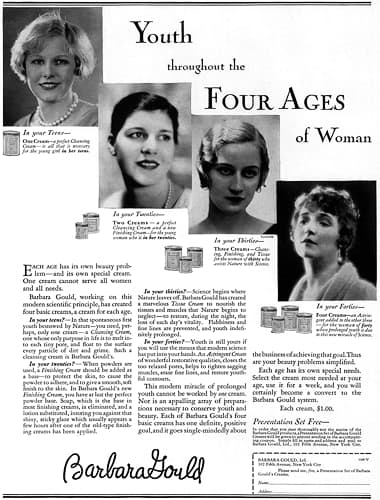
1929 Barbara Gould Four ages of Women.
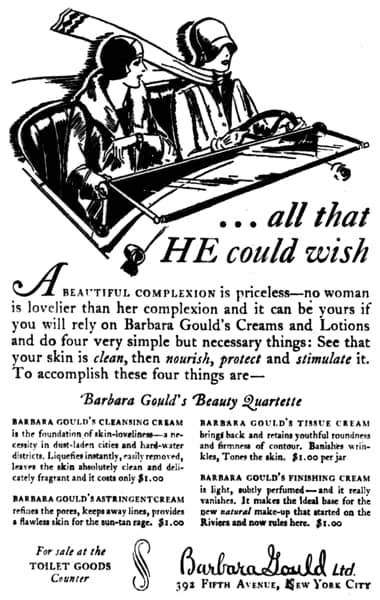
1929 Barbara Gould Beauty Quartette: Cleansing Cream, Astringent Cream, Tissue Cream and Finishing Cream.

1930 Barbara Gould: Your Years of Youth.
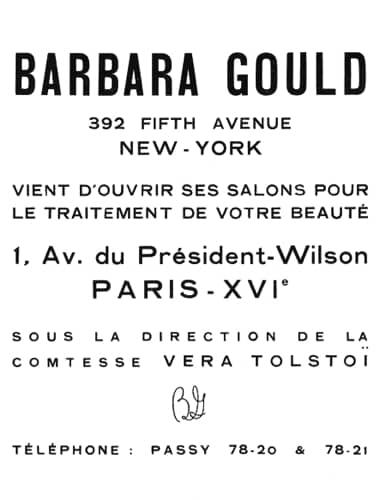
1930 Announcement of the opening of the Barbara Gould salon in Paris.
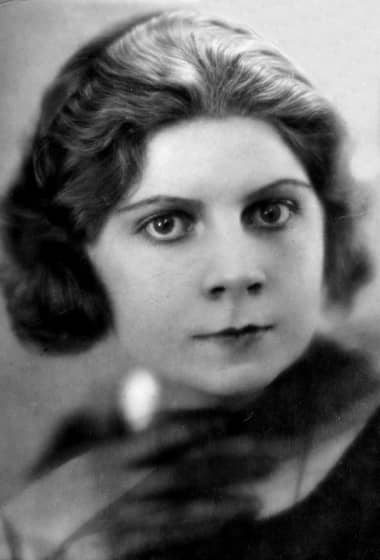
Countess Vera Tolstoy [1903-1999], a Russian émigré and the grand-daughter of Leo Tolstoy [1828-1910], was the first director of the Paris salon.
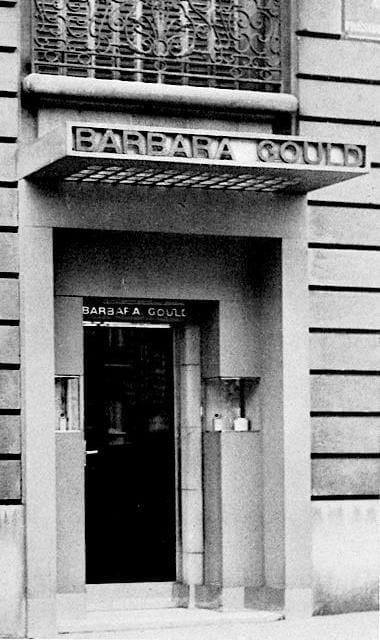
1931 Entrance to the Paris salon at 1 Avenue du Président-Wilson.
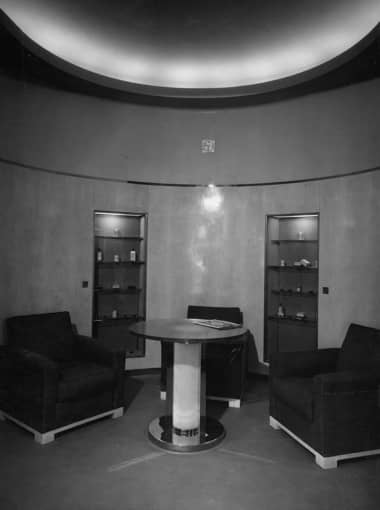
1931 Reception room in the Paris salon.
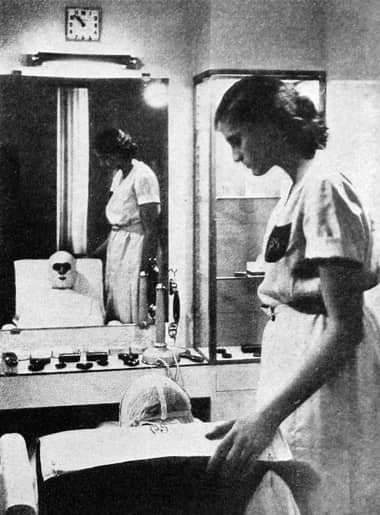
1931 Cubicle in the Paris salon.
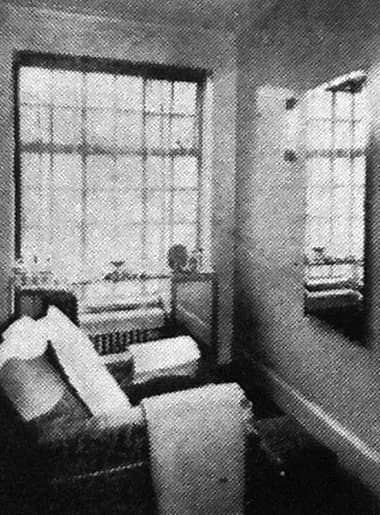
1931 Cubicle in the London salon.

1932 Miss Barbara Gould (Ruth Francis) about to get on a plane from New York to Boston to spend a week in the toiletries department at Jordan Nash. During the year she spent six months or so travelling around the United States promoting the line (AP&EOR, 1932).
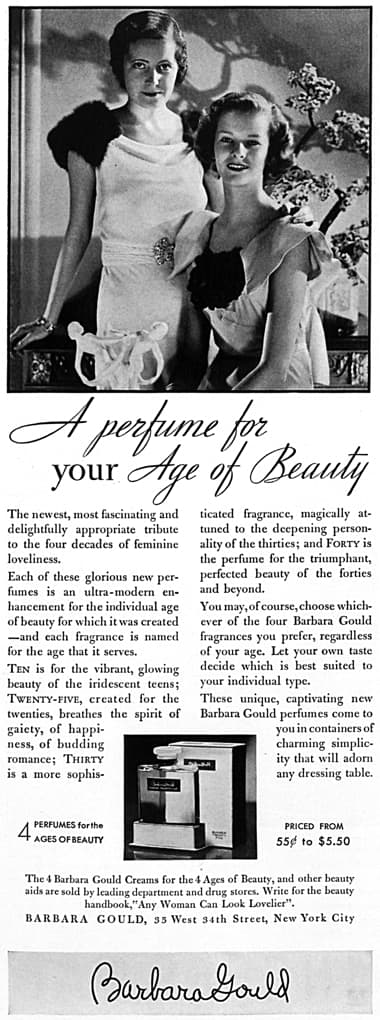
1933 Barbara Gould 4 Perfumes for the Ages of Beauty.
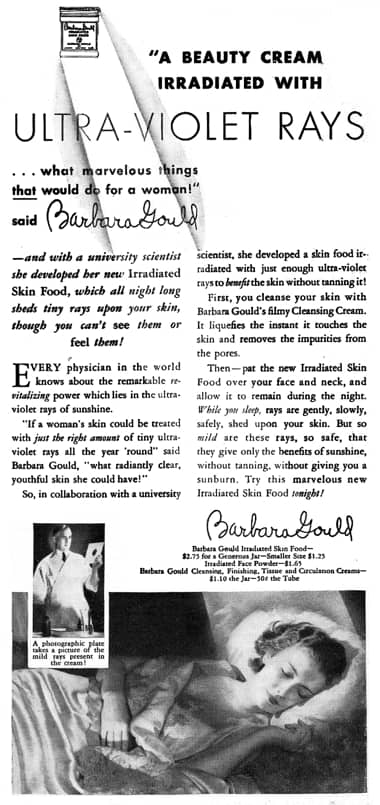
1934 Barbara Gould Irradiated Skin Food and Barbara Gould Irradiated Face Powder.
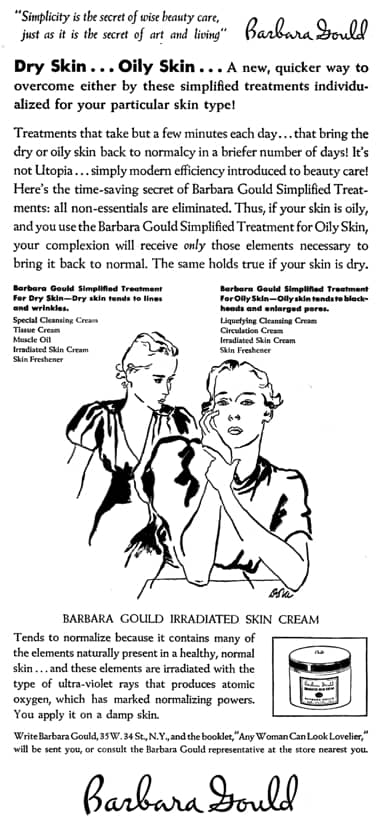
1936 Barbara Gould Simplified Beauty Treatments for dry and oily skin with Irradiated Skin Cream.
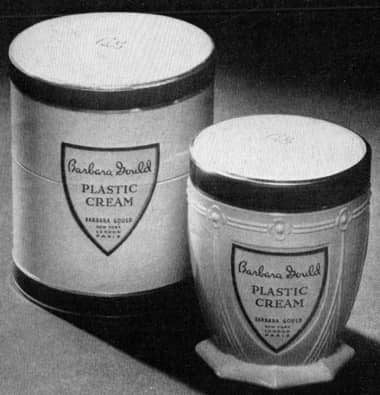
1936 Barbara Gould Plastic Cream and container box.
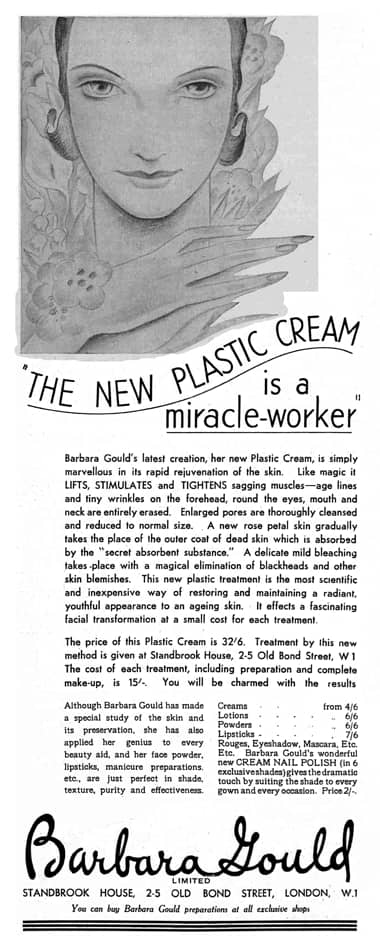
1936 Barbara Gould Plastic Cream (Britain). Note the use of the old signature.
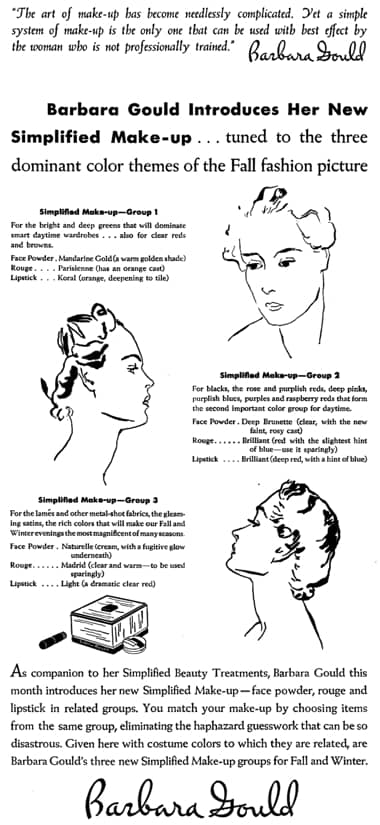
1936 Barbara Gould Simplified Make-up.
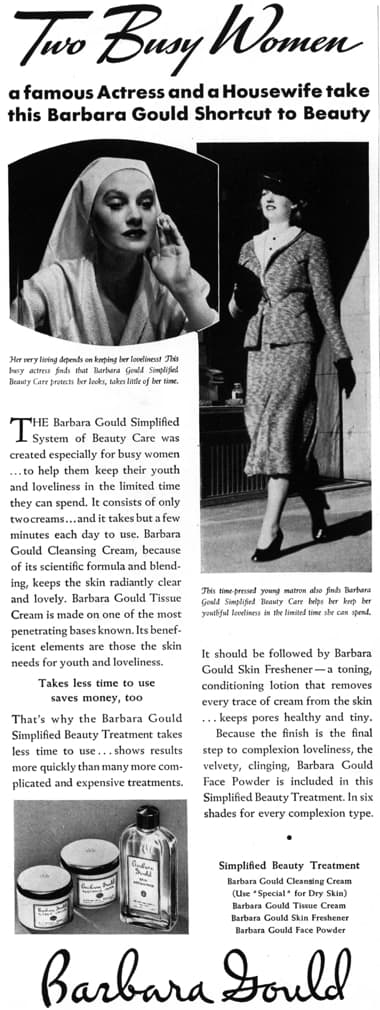
1937 Barbara Gould Simplified Beauty Treatment.
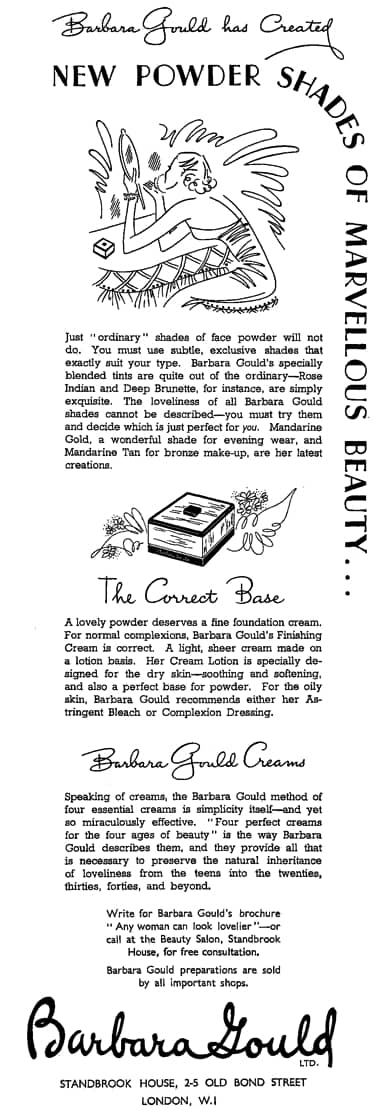
1937 Barbara Gould (Britain).

1938 Barbara Gould Velvet of Peaches Foundation Cream.

1938 Barbara Gould (Britain).
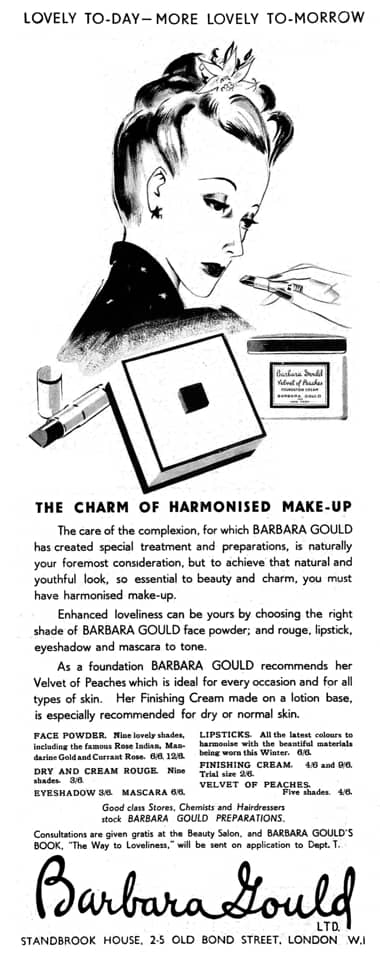
1938 Barbara Gould Harmonised Make-up (Britain).
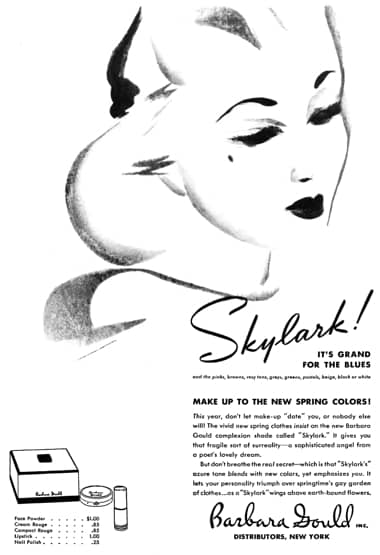
1940 Barbara Gould Skylark range.
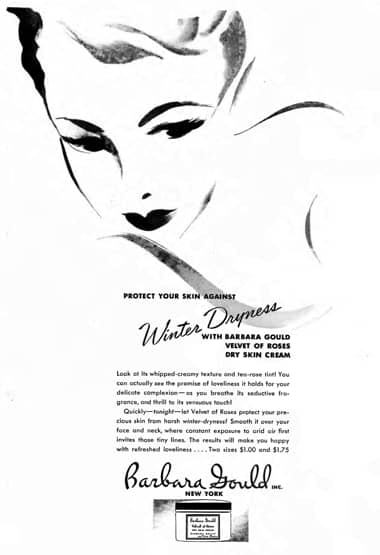
1940 Barbara Gould Velvet of Roses Dry Skin Cream.

1940 Barbara Gould Desert Rose Cream Nail Polish.
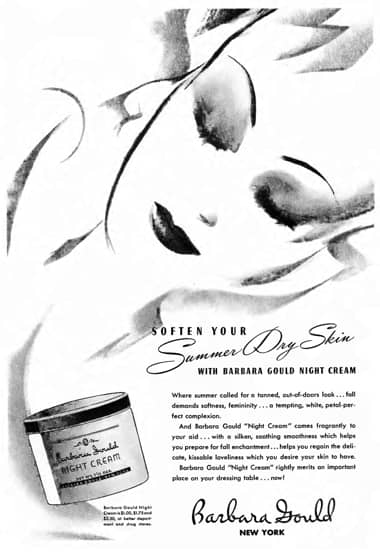
1941 Barbara Gould Night Cream.
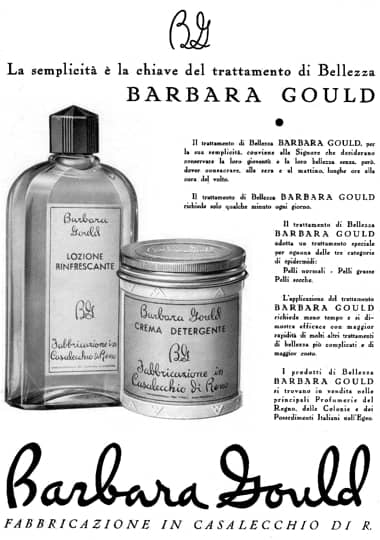
1941 Barbara Gould Lozione Rinfrescante and Crema Detergente (Italy).
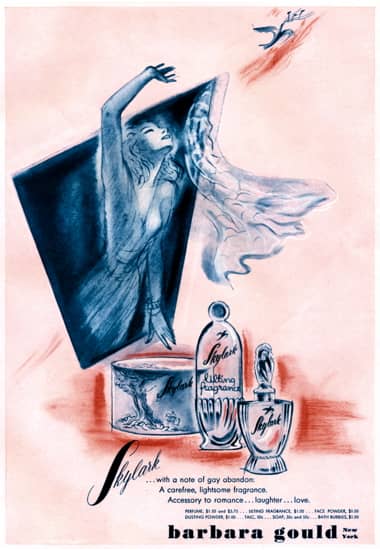
1941 Barbara Gould Skylark Face Powder, Lilting Fragrance and Perfume.
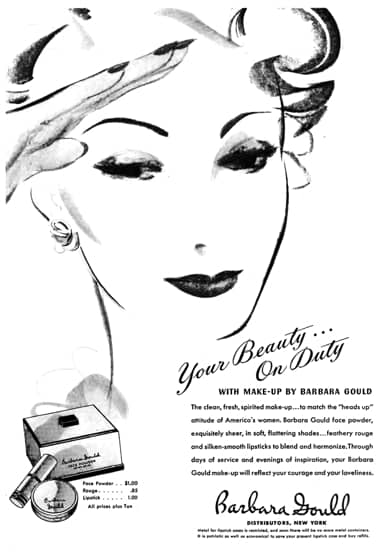
1942 Barbara Gould ‘Your Beauty on Duty’.
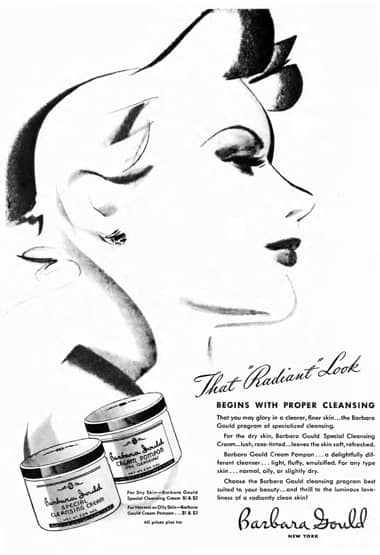
1942 Barbara Gould Special Cleansing Cream and Cream Pompon.
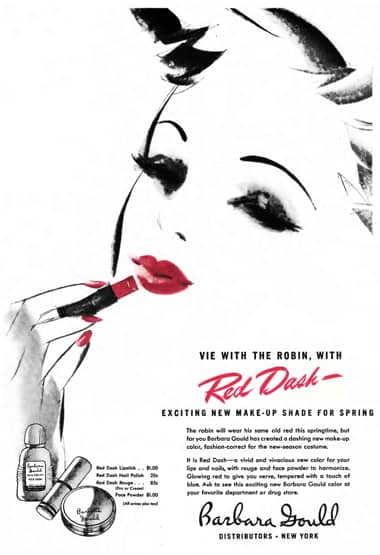
1942 Barbara Gould Red Dash Lipstick Rouge and Nail Polish.
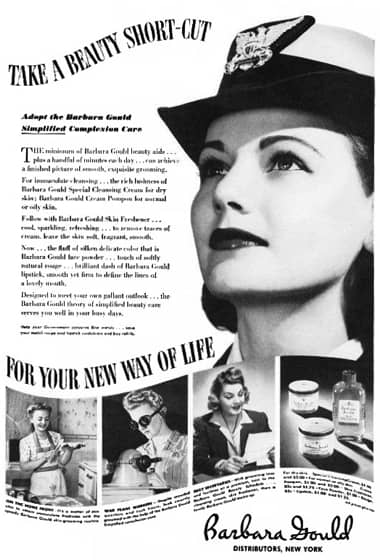
1943 Barbara Gould Special Cleansing Cream, Cream Pompon and Skin Freshener.

1944 Barbara Gould Harmonized Make-up.

1945 Barbara Gould Liquid Velvet.
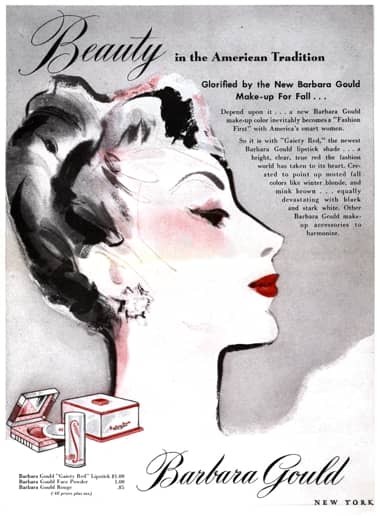
1945 Barbara Gould Gaiety Red.
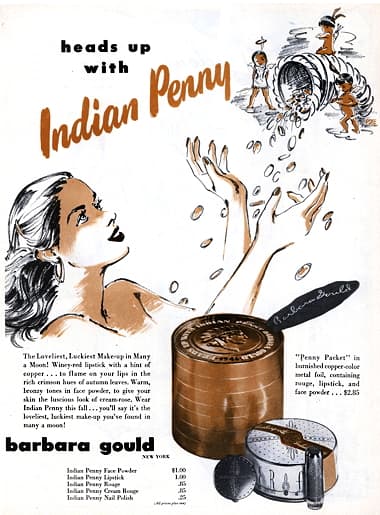
1946 Barbara Gould Indian Penny.
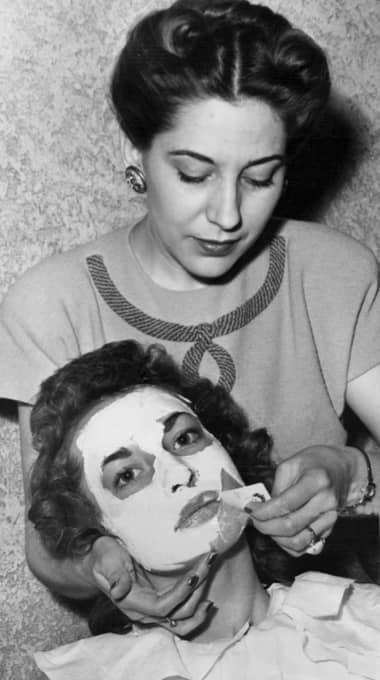
1946 Barbara Gould Beauty Pack.
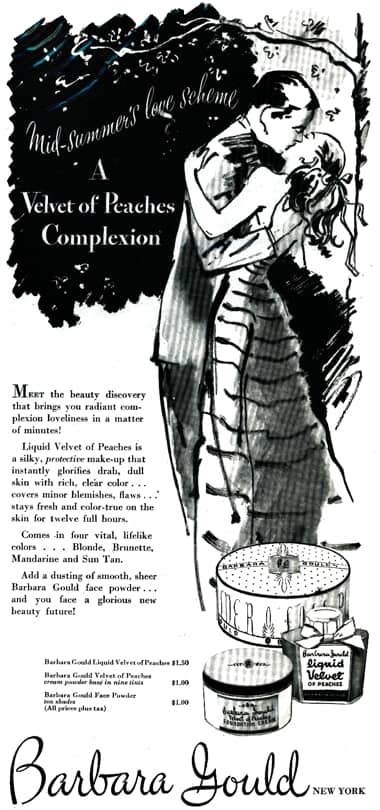
1946 Barbara Gould Liquid Velvet of Peaches.
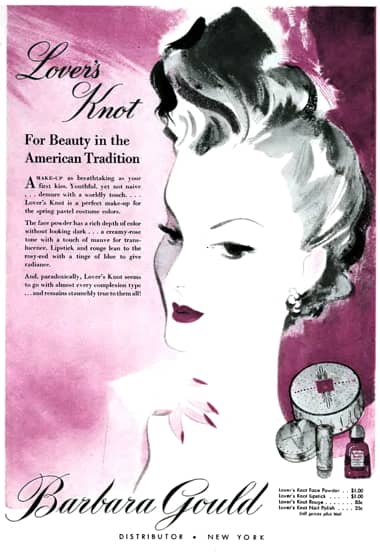
1946 Barbara Gould Lover’s Knot Face Powder, Lipstick, Rouge and Nail Polish.

1947 Barbara Gould Plastic Cream and Irradiated Beauty Cream.
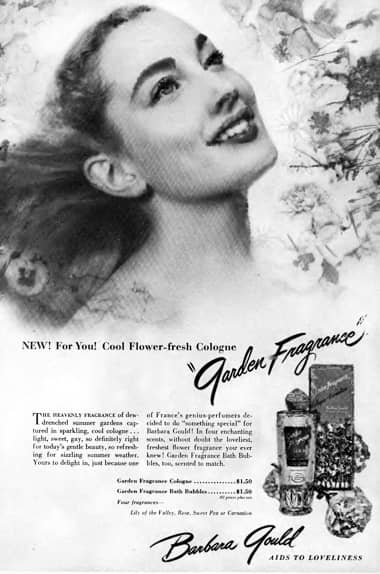
1948 Barbara Gould Garden Fragrance. The name Garden Fragrance had been registered by Woodworth back in 1918. It was first introduced into the Barbara Gould range before 1940 as an after bath body spray and as a rub in four variations – Carnation, Rose Geranium, Gardenia and Sweet Pea.

1950 Barbara Gould 1. Special Cleansing Cream, 2. Skin Freshener, 3. Velvet of Roses Dry skin Cream, and 4. Ramage Red Lipstick and Rouge.
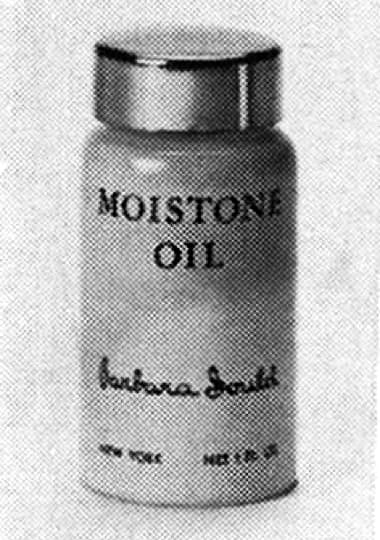
1952 Barbara Gould Moistone Oil.
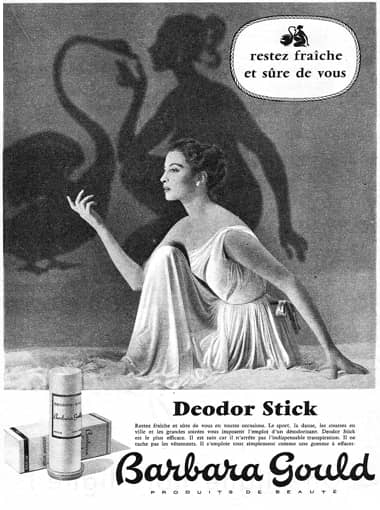
1956 Barbara Gould Deodor (France). Barbara Gould also made a cream deodorant and a liquid antiperspirant.
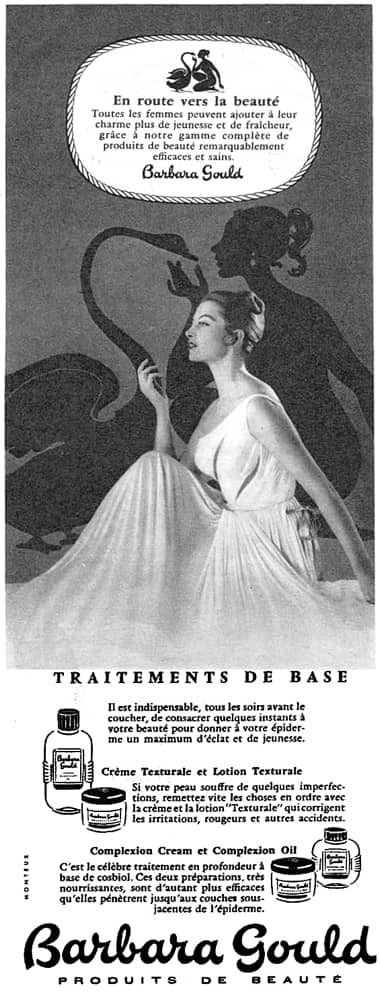
1955 Barbara Gould Produits de Beauté (France) using the new ‘Leda and the Swan’ logo. The Traitments de Base are Barbara Gould Crème Textural, Lotion Textural, Complexion Cream and Complexion Oil.
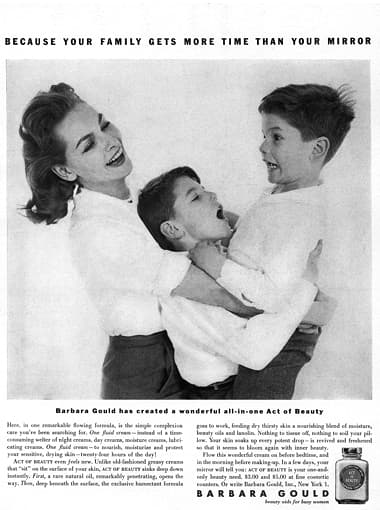
1956 Barbara Gould Act of Beauty.
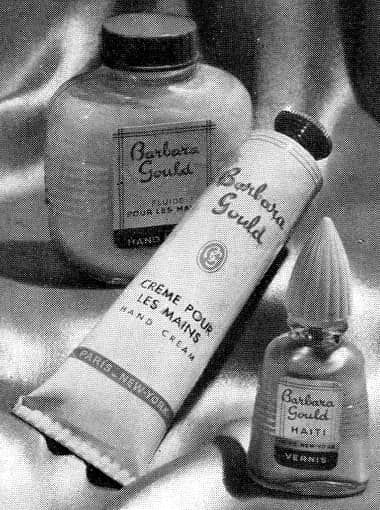
1956 Barbara Gould Fluid Pour les Mains (Hand Lotion), Crème pour les Mains (Hand Cream) and Vernis à ongle (Nail Polish) in Haiti shade (French). Similar products were available in the United States.
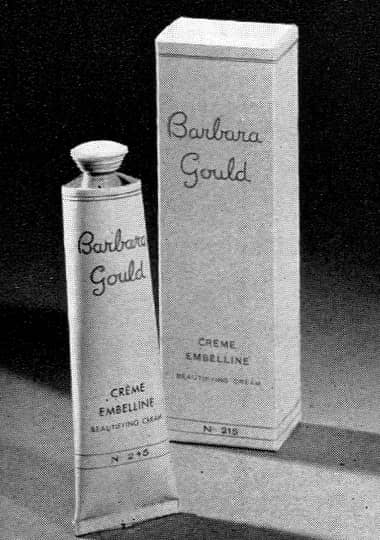
1957 Barbara Gould Crème Embelline (France).
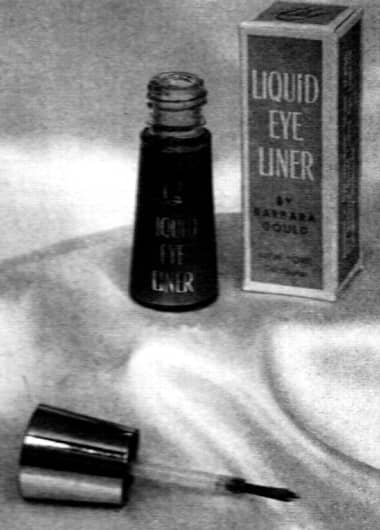
1959 Barbara Gould Liquid Eyeliner.
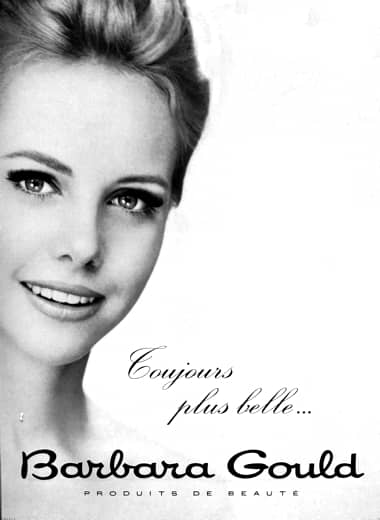
1962 Barbara Gould Produits de Beauté
